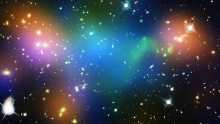Most galaxy clusters, groups that can contain thousands of galaxies, contain lots of dark matter in addition to your normal, well-studied visible matter. We're still fuzzy on exactly what dark matter is or why it does what it does, but we've been able to pin down that it interacts through gravity like normal gravity does. It just doesn't give off any light. Scientists speculate that dark matter anchors visible matter to a specific location; wherever you see large quantities of regular matter in the cosmos, you're going to run into a bunch of dark matter, too. In most galaxy clusters, it shows up in predictable quantities and behaves in strange but determinable ways.
Most of the time. Sometimes dark matter shows up and makes no sense at all. The center of Abell 520 is one such example. A 2007 study indicated that the center of the cluster held a gigantic core of dark matter that should have pulled in lots of visible galaxies. But scientists could see no visible matter surrounding the core. It just hung in the sky on its own, surrounded by smaller spots of dark matter that were attracting galaxies just fine. Astronomers didn't know what to make of it, so they dismissed it as a mistake in their observations. But a new analysis with the Hubble telescope shows that there was no such mistake.
The dark core is very real. It's there, bending light with its huge mass like any other enormous object in space. It's just not interacting with any visible galaxies.
There are a few possible explanations for the presence of this giant glob of heavy nothing. There could be a few very faint galaxies hanging out where the Hubble can't see them, or dark matter might potentially be interacting with itself in ways previously thought impossible (it doesn't seem to attract itself normally; it just sucks up visible matter). Or we could be witnessing a weird moment in interstellar ballistics, an instance in the vast collision that we hadn't accounted for with our understanding of how galaxies crash into each other. Scientists will be running computer simulations of the Train Wreck crash to see if there's something they're missing. Either we'll discover something new about collision physics or we'll have to investigate deeper into how dark matter operates.
